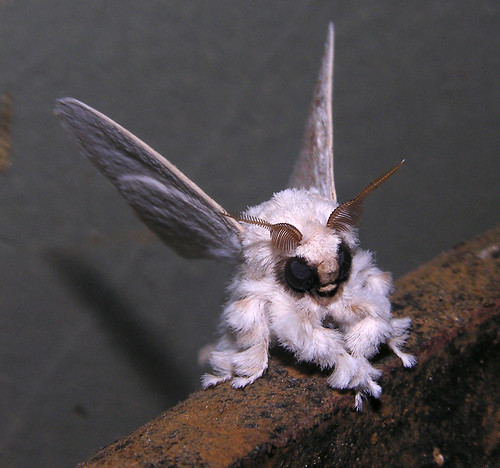થોડા મહિના પહેલાં તમે ઘણા કદાચ આ સંભારણામાં સમગ્ર stumbled – the famous Poodle Moth! અને ખરેખર મોટા ભાગના ભાગ માટે રિપોર્ટિંગ અડધા યોગ્ય હતી. હા, તે વાસ્તવિક છે. હા, તે શલભ છે. હા, તે કદાચ Lasiocampidae એક પ્રજાતિ છે (possibly the genus Artace) કારણ કે યોગ્ય રીતે ડૉ દ્વારા ધ્યાન દોર્યું. જ્હોન Rawlins.
I expected this to be all well and good, hey there are tons of cute moths out there and it’s about time someone noticed! I didn’t bother to read the article until a colleague forwarded it to me from the “Cosmic Log on nbcnews.com“. What I found was horrifying hilarious. NBC for some reason decided to cite a cryptozoologist who was one of the first people to apparently blog about this moth and attempt to identify it (incorrectly, but not a bad effort for a non-entomologist). And then stories like this one in the Christian Post started popping up everywhere: Venezuelan Poodle Moth Confuses Scientists. For some reason they all love using lines like “mystifying researchers”, અથવા “baffling scientists”. I’m always amused by the catch words used in stories like this – and don’t really understand why they are so popular. I guess every time a scientist says “boy this is interesting” it gets misinterpreted as them being baffled; which makes me think the reporter might enjoy knocking science off of its imaginary ivory tower when they get to say “hey look these stupid scientists don’t even know the answer”. And while we often don’t know the answer (it’s sort of our job to discover those answers), it doesn’t mean we’re stumped. Especially in this case, it’s just a fluffy moth.
No real harm, but that whole cryptozoology thing gets me riled up. I think its unfortunate that a cryptozoologist nabbed so much publicity and was talked about with a fair amount of credibility.
Cryptozoology is not a science, nor will it ever be. When cryptozoology is conducted as a science it’s called biology.
Yes there are nuts out there who believe they are conducting real science, following tall tales in circles and building stacks of anecdotal “evidence” that never seem to result in truths. There are real differences between what a scientist and a pseudoscientist does. Say a scientist hears reports of an odd animal living in the deep jungles – they embark on an expedition (after begging for funding) to do the hard work of piecing together local stories and trekking the jungles or diving the oceans to find the specimens. Then they bring those specimens home, dissect every detail, and publish the results in a peer reviewed journal. If no specimens were found then that scientist goes home empty handed and rethinks the possibility of this new mythical creature. Maybe more funding would give them more time in the field… (always the answer, જમણી?) But the story ends there, without evidence the animal doesn’t exist. This is where cryptozoology departs from real science – they embrace anecdotal tales as fact and never admit defeat. Nessy exists because people જુઓ him. The explanation can’t possibly be any large array of more plausible options… because the world a cryptozoologist lives in is mythical and fundamentally not real.
OK enough ranting, let’s just hope for more adorable moths hitting the news cycle!


કૂવો, first of all, screw you. I personally have a great interest in cryptozoology and your lack of understanding is appalling. A cryptozoologist does all the things you said a “real scientist” does and then yes, that’s it. Media hype and redneck fools continue nonsensical chases. Not real cryptozoologist. Cryptozoology is a social science and an analysis of mythology and folklore from around the world. It gathers anecdotal evidence because that’s what gets you that ever-elusive funding. And never amounts to anything? Try rods: creatures reported by photographers all over and conclusively disproven. The gorilla: found and then classified. THATS where a biologist comes in in that case. After the fact. The giant squid: a legend researched and analyzed and a figure from medieval culture that, guess what, was true. Because that’s what real cryptozoology is. Not idiots who desperately cling to children’s stories, not pseudoscientific nut-jobs, but men and women who keep legends alive and continue to analyze them for new meaning and yo make new theories based on current science and who often brave harsh conditions to search for creatures out of personal expense. Many of them ate biologists themselves. So before you judge everyone, know what you condemn.
Thank you for your comment, I’m glad you were able to hold it together past your opening line. You may disagree with me, but your anger is misplaced. If you’re interested in working with “social-science and an analysis of mythology and folklore” perhaps you should consider looking into cultural anthropology or history, both fields provide lots of outlets for exploring the world and its legends.